XTAR seems to have focused on “1.5V Li-ion batteries” recently and has developed a new charger that can do more than just charge this type of battery.
The XTAR VX4 supports Li-ion, NiMH, LiFePO₄ and 1.5V Li-ion batteries and can not only charge these types, but also test their capacity.
You can find the German version of this review on my website: SammysHP Blog › XTAR VX4 „Visible Mixer“
The charger was provided by the manufacturer for this review. Thank you very much!
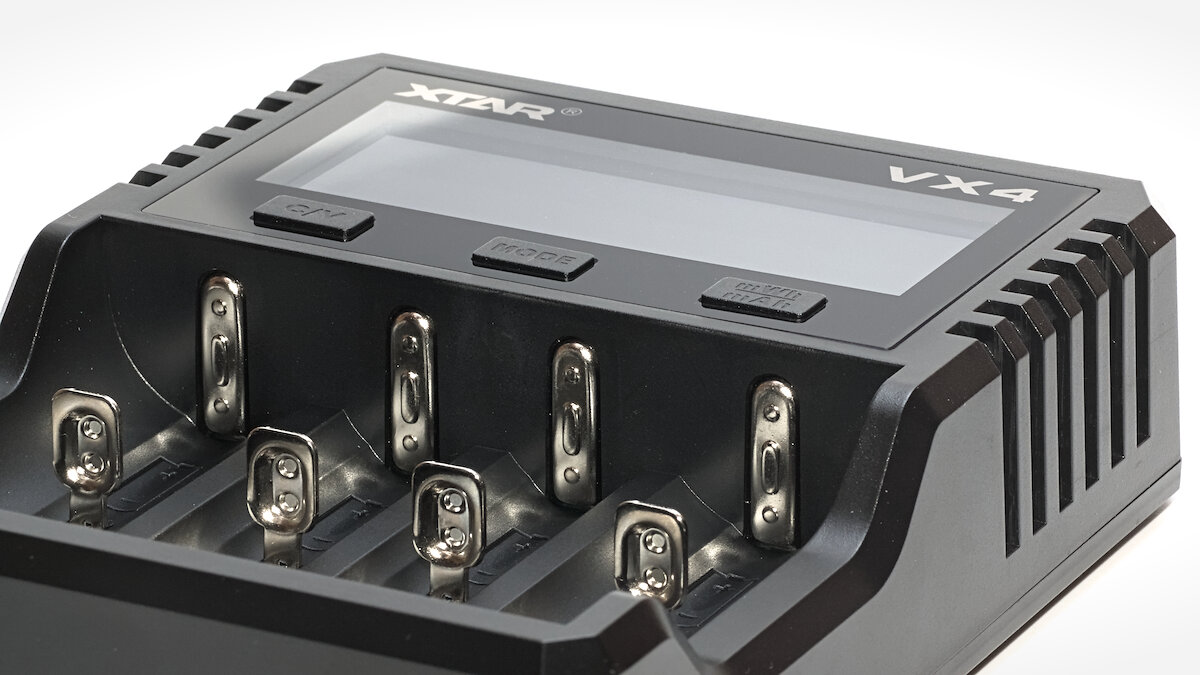
Overview
The “Visible Mixer”, as the VX4 is described by XTAR, is available either standalone or as a set with a 20 W USB-C power supply (5V 3A / 9V 2.22A / 12V 1.67A). The detailed manual is available in eleven languages (CN, EN, RU, DE, FR, ES, IT, TR, JA, EL, PL).
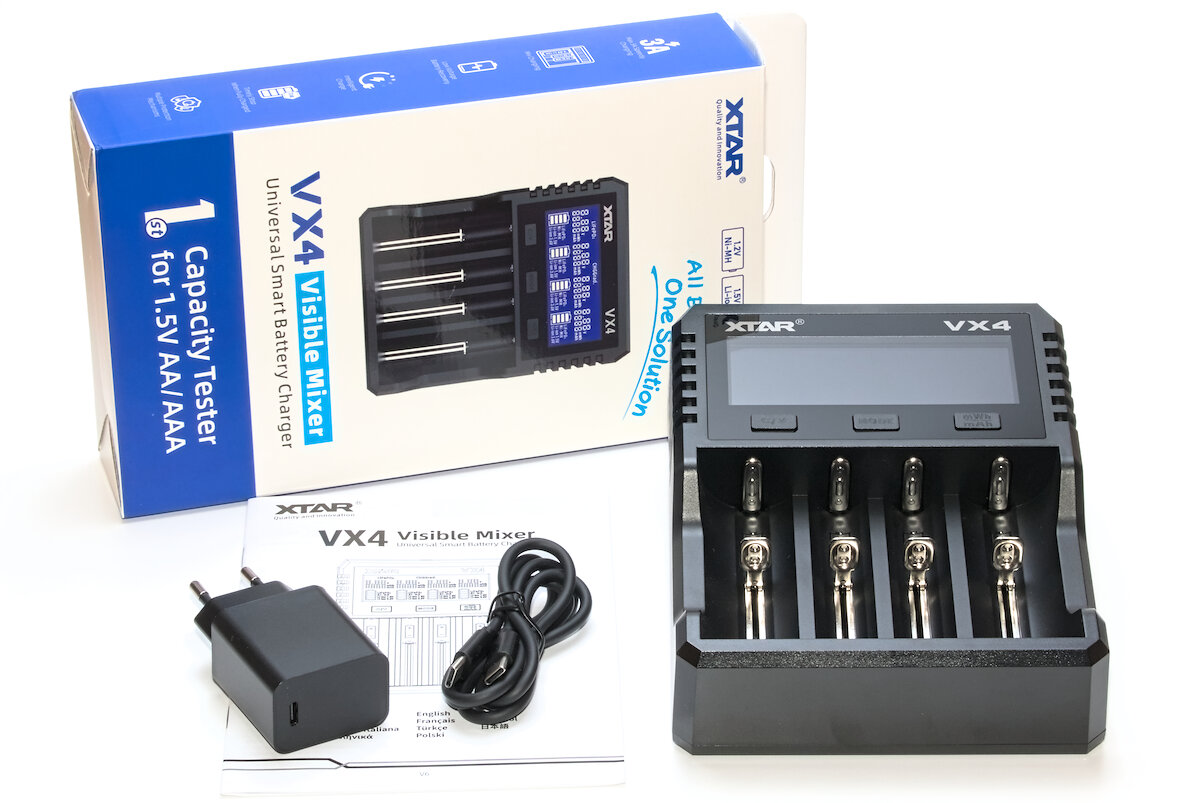
Four charging slots, three buttons with a large display above, with ventilation slots at the sides and bottom. The charging slots only make up just over half the length of the device.
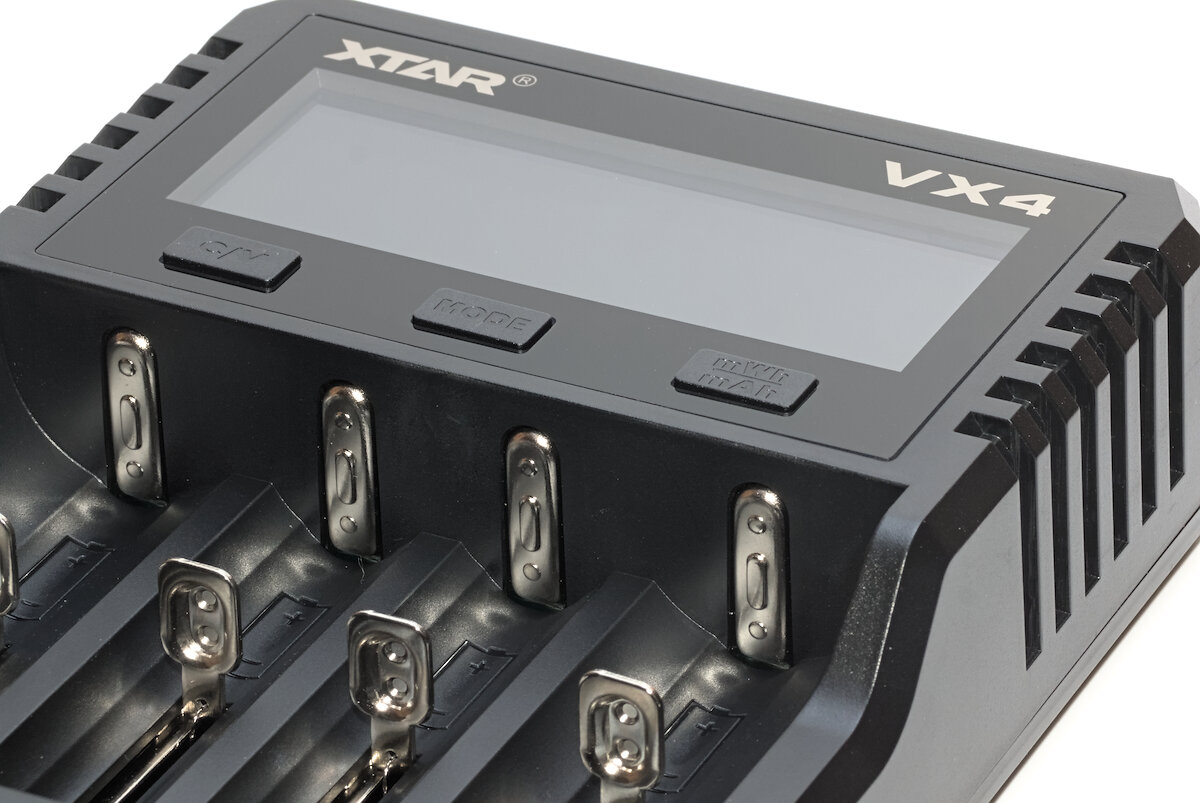
There is a USB-C port at the back for the power supply. Although the VX4 also works with a classic 5V power supply, a more powerful USB PD/QC power supply is required for full charging speed.
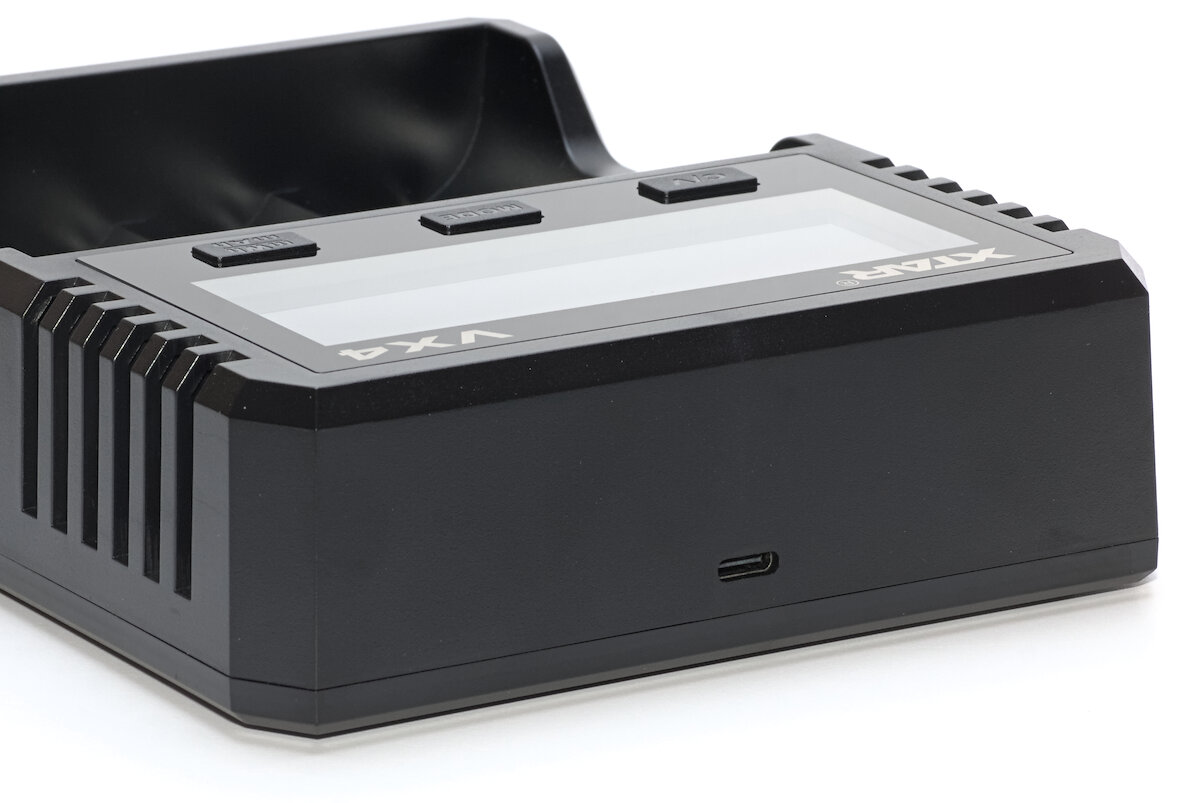
I have to highlight the battery contacts: There are small nipples on both sides, which ensures good contact even with different battery sizes. Only flat-top batteries with a protruding wrapper could cause problems with the positive terminal. With thin batteries (e.g. AAA), you should check that they are seated correctly.
The sliders run smoothly and without getting caught. This means that batteries can also be inserted with one hand without having to pull the slider back first.
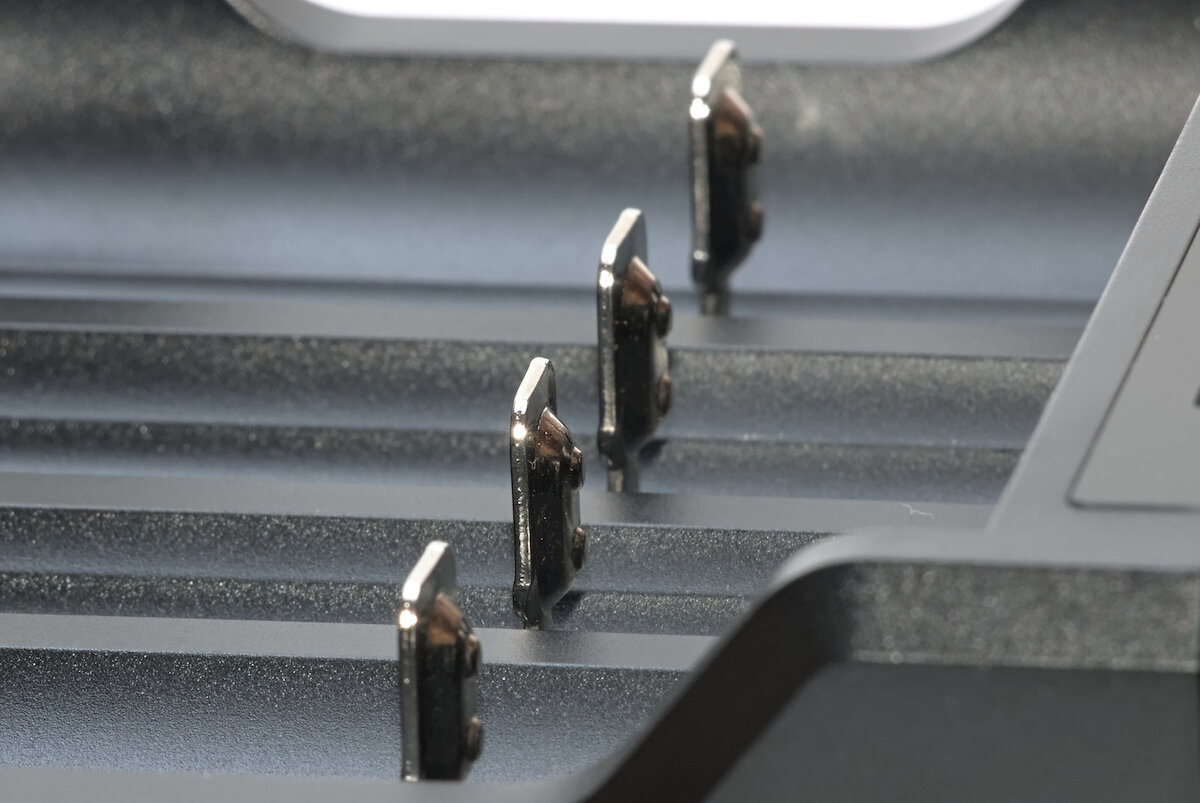
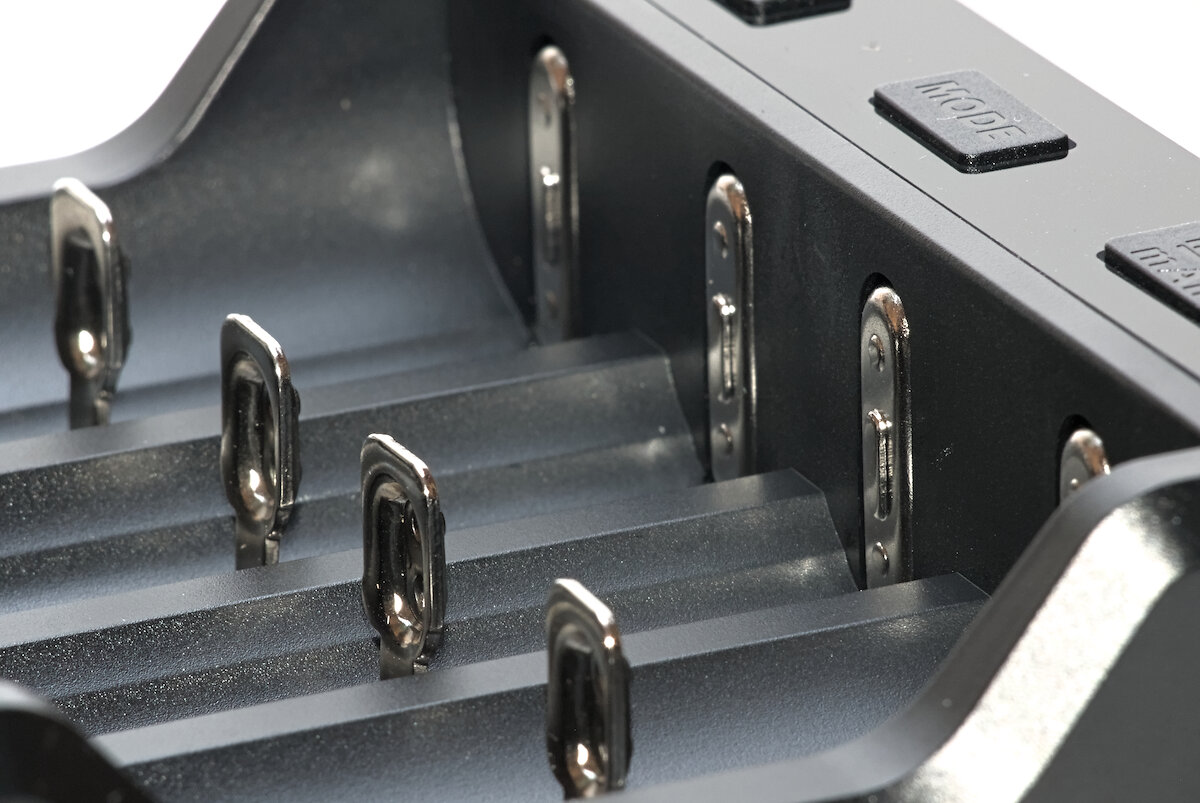
The slots have a length of 29.0 to 80.5mm and therefore support a wide range of battery sizes. Even many 26800 batteries will fit.
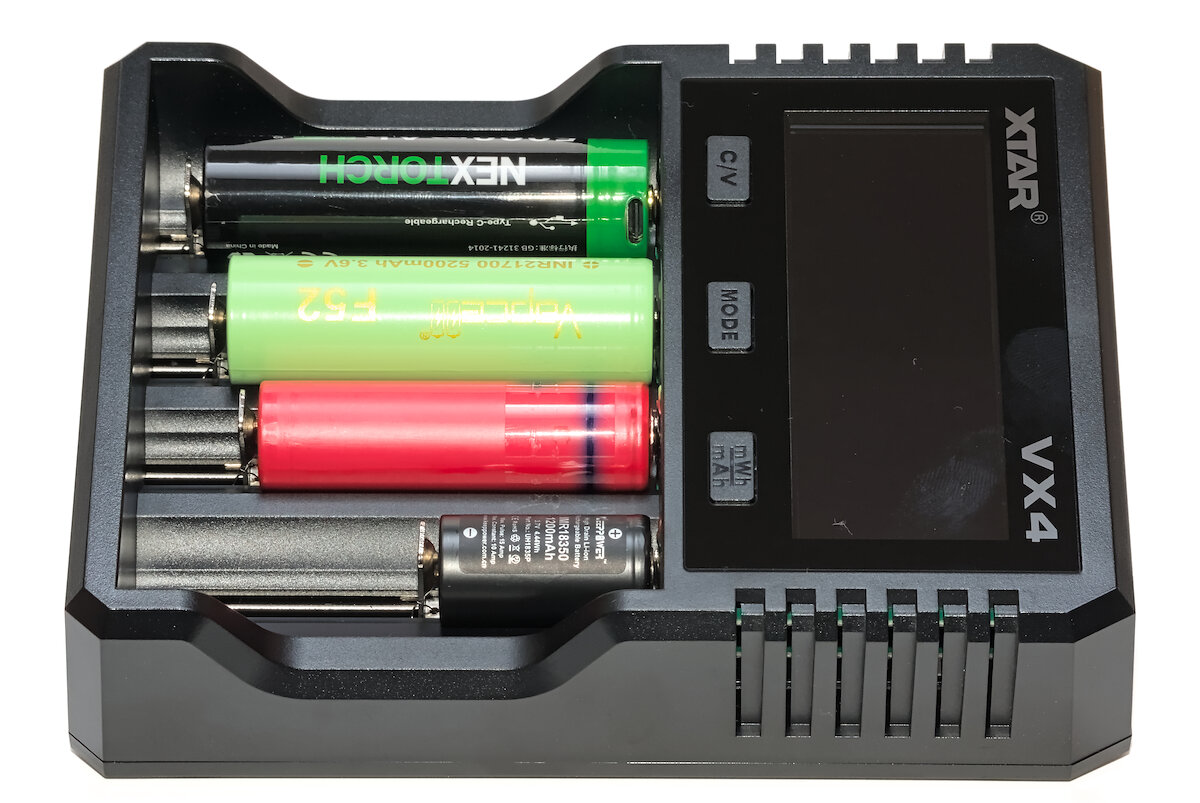
The two outer slots can each accommodate batteries up to a diameter of around 33mm, while the two middle slots are a little narrower at around 23mm. The total width shared across all four slots is 112mm. This means that four 21700 batteries or two 26650 batteries together with one or two narrower batteries can be charged at the same time.
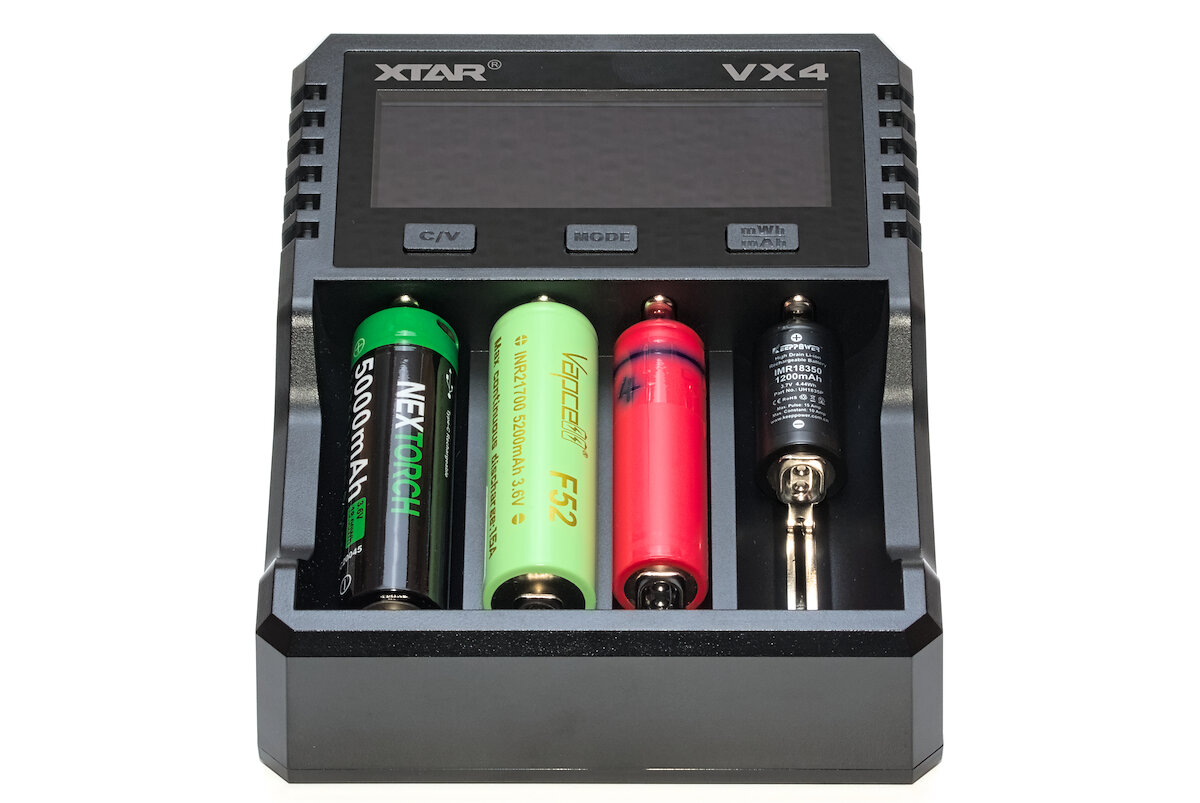
The backside has a list of electrical parameters and supported battery sizes. Of course, other sizes that are not explicitly listed can also be charged, as long as they fit into the device.
Unfortunately, the four feet are part of the case and are therefore made of plastic. This means that the charger slips easily on the table and usually has to be held firmly when inserting batteries. Rubber feet would have been helpful.
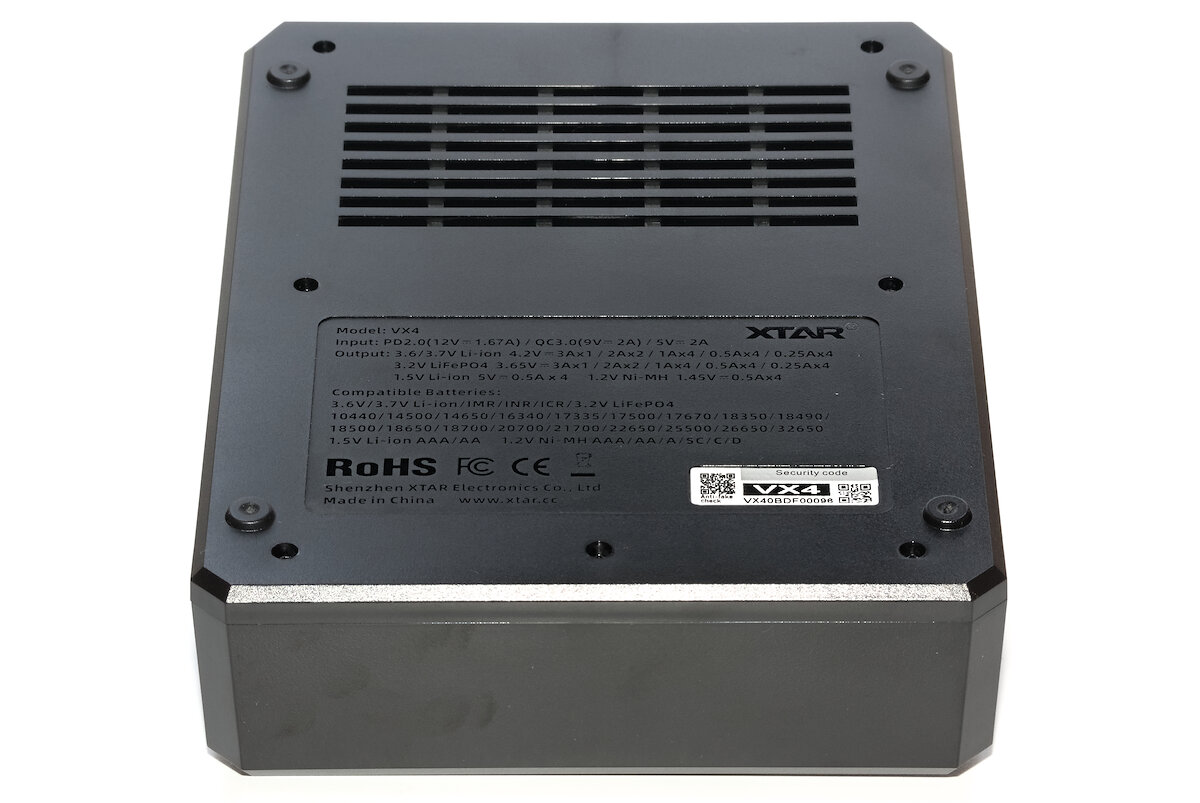
With dimensions of 171 × 129 × 41 mm and a weight of 313 g, the VX4 is not exactly what I would call compact.
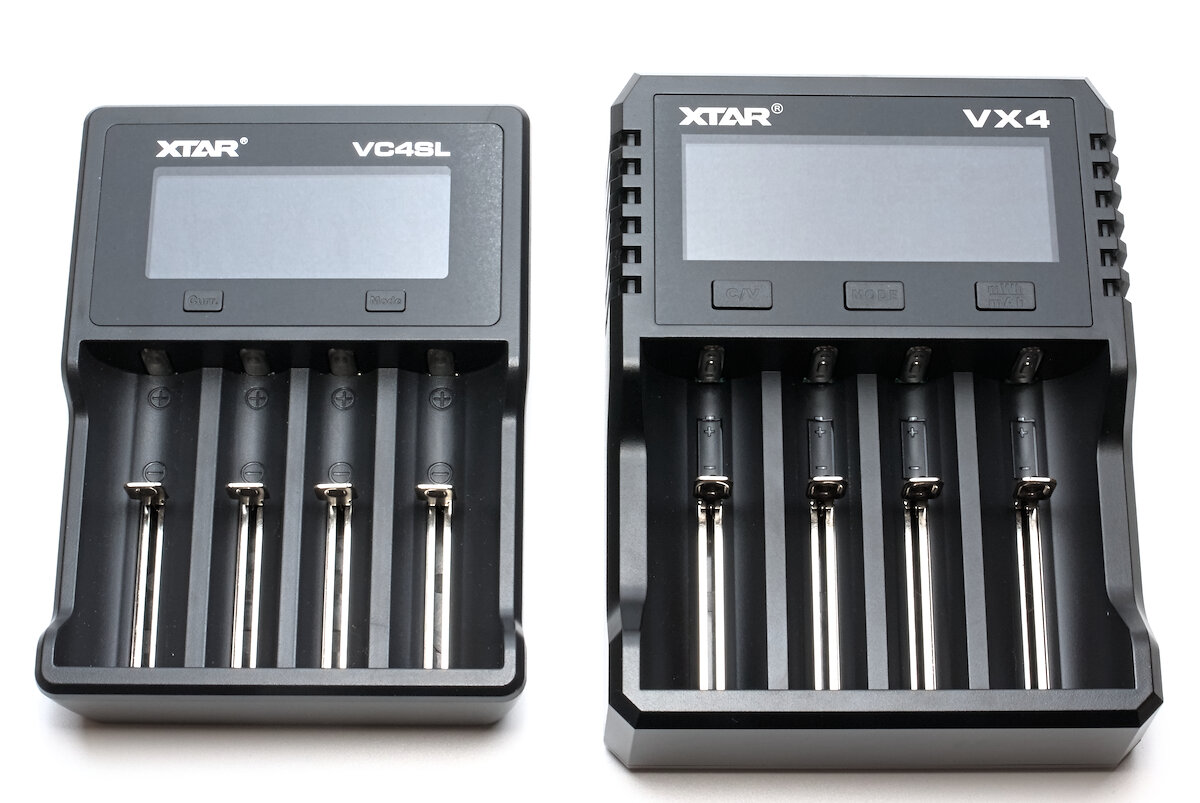
The build quality is very good. Everything fits perfectly, nothing creaks and the case feels sturdy.
User interface and features
With a diagonal of 95mm and the large numbers, the display is easy to read. Is this what makes it a “Visual Mixer”? Thanks to the high brightness and good contrast of the white text on blue background, it is easy to see even in the sun. The brightness is automatically reduced after one minute. However, the display can also be switched off completely if desired (see below).
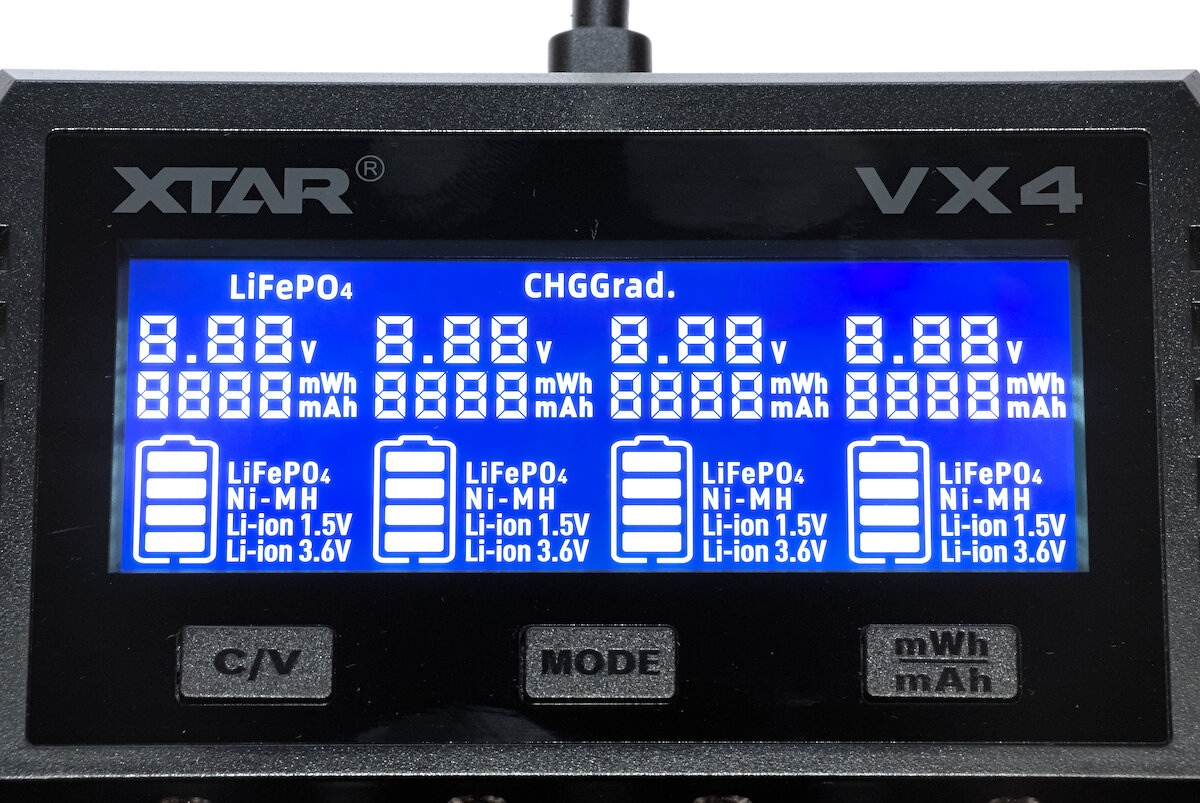
After power on, all segments of the display are shown for a few seconds. During regular operation, the battery type, voltage and real-time charge/discharge current are displayed for each occupied slot. The progress is also shown via an animated icon. At the top there is an indicator for the operating mode: “CHG” (Charge) for charging or “Grad.” (Grade) for the capacity test.
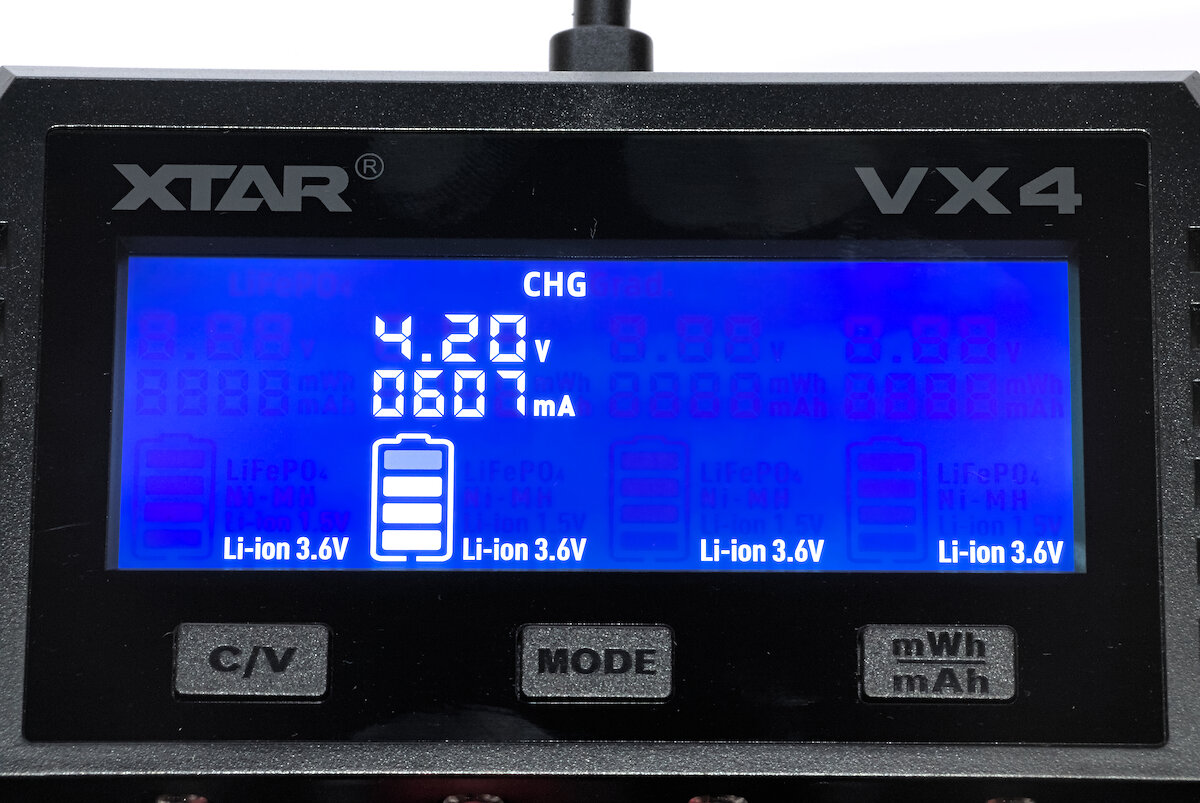
There are three buttons below the display to control the charger. Depending on the lighting, the labels are either difficult or impossible to read. From left to right, they read: “C/V”, “MODE” and “mWh/mAh”. When pressed, they produce a clearly audible and perceptible click. Their function is easy to explain:
| Button | Short press | Long press |
|---|---|---|
| C/V | Select maximum charging current | Switch between normal and LiFePO₄ charging mode |
| MODE | Switch between showing real-time charging current and charged capacity | Switch between charging and capacity test mode |
| mWh/mAh | Switch between mWh and mAh (only in 1.5V Li-ion mode) | Turn off backlight |
The charging current can be limited in five steps (250, 500, 1000, 2000, 3000 mA) by short pressing the C/V button. However, the actual charging current also depends on the number of batteries inserted and the measured internal resistance. Thus it can happen that you want to charge a single battery with 2000mA, but it is only charged with 500mA due to poor contact or an inaccurate IR measurement. Although the internal resistance is measured to determine the maximum charging current, it is not displayed. However, this type of measurement is not really accurate anyway.
Holding the MODE button switches between normal charging mode and the capacity test, in which the battery is first charged, then discharged and finally charged again. When discharging, the capacity is measured and then shown on the display. The discharge current is fixed at approximately 300mA and cannot be changed. With large batteries, it can take over half a day.
Important: All settings operate on all four slots together! This applies to the set charging current limit as well as to the operating mode or LiFePO₄ mode. The NiMH and 1.5V Li-ion types are automatically detected and can therefore be charged together with normal Li-ion batteries. Li-ion and LiFePO₄ batteries on the other hand, cannot be charged simultaneously. Automatic detection of LiFePO₄ batteries is not possible. If you try to charge them in normal Li-ion mode, they will be overcharged and damaged.
The third button only works with 1.5V Li-ion batteries and switches the display between mAh and mWh. A long press switches off the display. The next press switches it on again.
Measurements
As the capacity test includes the normal charging process at the end, I have limited the charts below to this mode.
At this point I would like to emphasize that these are not high-precision laboratory tests. Electrical engineering is just one of my hobbies, which means that I have various devices at hand gain some insight into how things work. For many of the measurements in this review I only used two inexpensive multimeters with Bluetooth connection. One for voltage measurement, the other for current measurement via a shunt (again, with the materials I had available - two 0.1Ω 10W resistors in parallel). Furthermore, the measurements shown here are just samples and could vary from other tests.
You can find more measurements in the fantastic review by Tim McMahon.
Li-ion
Li-ion batteries can be charged with 250, 500, 1000, 2000 or 3000 mA. However, the actual charging current is also limited by the number of batteries inserted and the measured internal resistance. In my test I had to clean the charging contacts thoroughly and press them firmly together to charge the battery with more than 250mA. However, this is also partly due to my measurement setup, which increases the resistance.
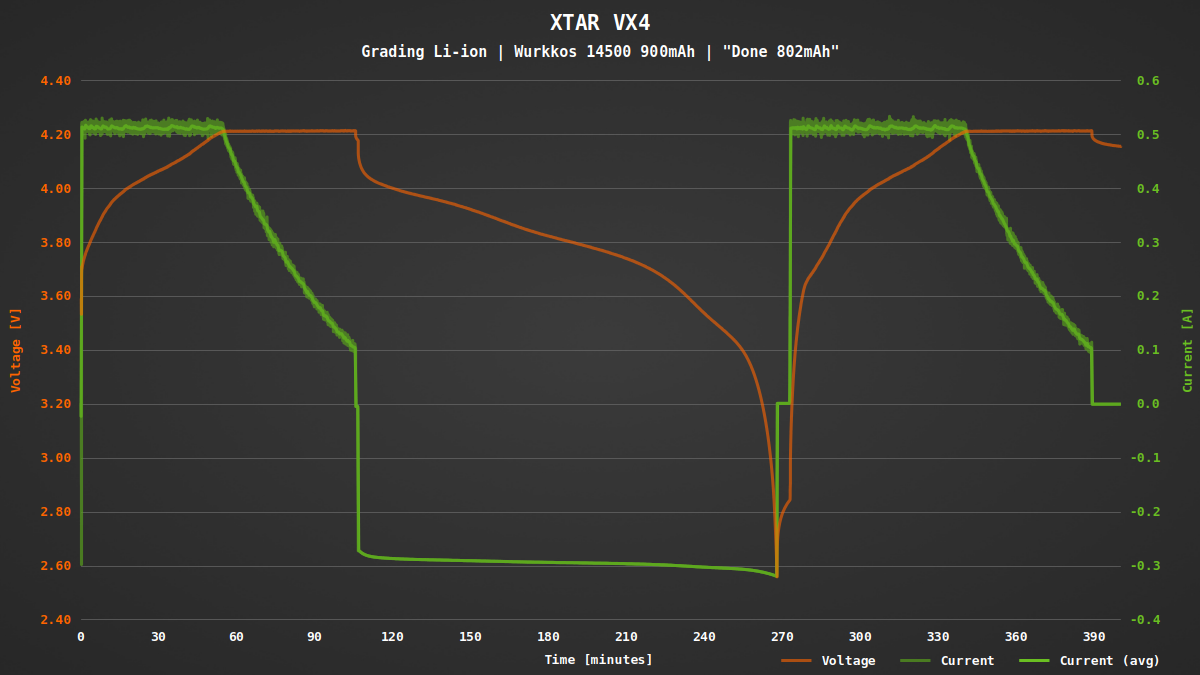
The CC/CV charging method used for Li-ion batteries is pretty much straightforward as long as it doesn’t exceed 4.20V significantly and the charging process is terminated when the current is low. So far it looks perfectly fine in the VX4. The charging current is somewhat noisy, but this is not a real problem.
In LiFePO₄ mode the target voltage is reduced (3.65 V according to the manual). Unfortunately I do not have a LiFePO₄ battery that fits into the charger.
NiMH
Unlike Li-ion batteries, NiMH batteries are charged with a fixed current of 500mA in the VX4. This current is slightly too high for some small batteries and lower than necessary for others, meaning that the charging process takes longer.
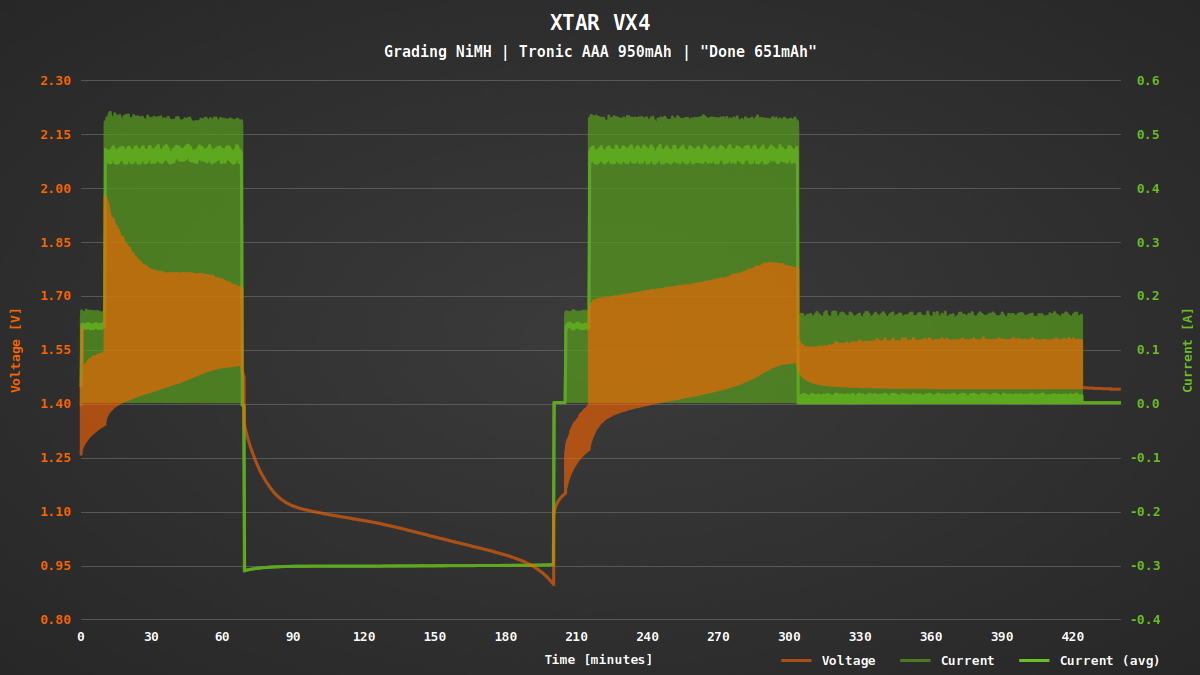
With NiMH batteries, the charging is periodically interrupted to measure the open-circuit voltage of the batteries. This results in the large fluctuations shown in the diagram. It is the usual charging method for NiMH and perfectly acceptable. Due to my measurement setup the effect is stronger than normal, but the VX4 had no problems with this. Apparently it was even able to terminate the charging process using the -dV/dt method.
At the beginning the batteries are pre-charged with a reduced current of around 180mA, after ten minutes the current is increased to 500mA. After termination, the batteries are trickle charged for two hours.
1.5V Li-ion
This type consists of a Li-ion battery and a tiny voltage regulator, which outputs a constant voltage of 1.5V from the 2.7-4.2V of the Li-ion battery. This type makes sense when devices have problems with the lower voltage of NiMH batteries or partially discharged alkaline batteries.
Many models of this type also have the charging circuit integrated and only need 5V applied at their terminals. This reduces the “charger” to nothing more than a battery holder. However, the VX4 can do more and measure their capacity as well. According to the manufacturer, it is the first charger that can test the capacity of 1.5V Li-ion batteries. (In fact, I am not aware of any other charger with this function, with the exception of the Gyrfalcon S8000, which is not released internationally.)
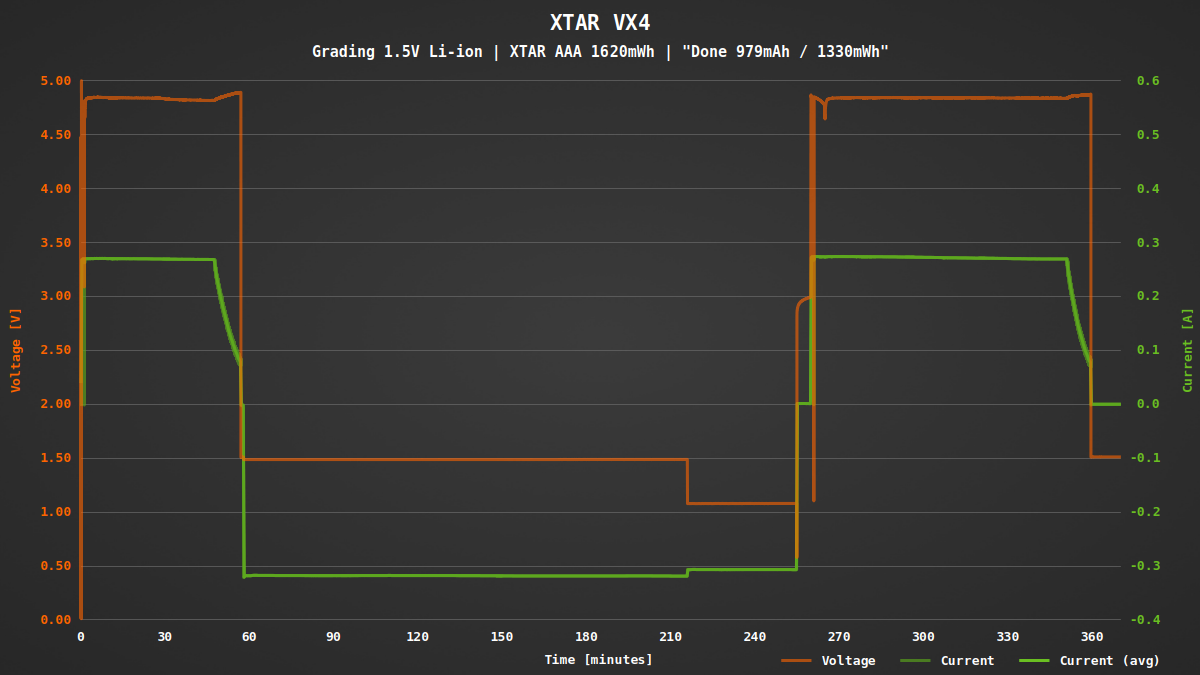
The measured capacity matches my own measurements (and is also significantly lower than the advertised capacity, which refers to the internal cell and does not include the losses from the voltage regulator).
Conclusion
The XTAR VX4 is a multi-chemistry charger for Li-ion, NiMH, LiFePO₄ and 1.5V Li-ion batteries. The charging current (max 3000mA) can be limited in five steps down to 250mA, but only for all four slots together. The actual charging current might also be significantly lower than selected due to the sensitive IR measurement. NiMH batteries are always charged at 500mA regardless of the chosen current.
An additional function is the capacity test, which is used to determine the capacity of the batteries. It also works for 1.5V Li-ion batteries, which makes the VX4 pretty unique right now. However, with a discharge current of only 300mA, the test can take a while. The large display is easy to read, even in sunlight.
Overall, the user interface is straightforward and easy to understand. With the limited set of functions it is often enough to just insert the batteries and wait for the charging to finish. If you can live without the capacity test, the adjustable current limit and the slightly longer slots, the more compact XTAR MX4 would be a good alternative.